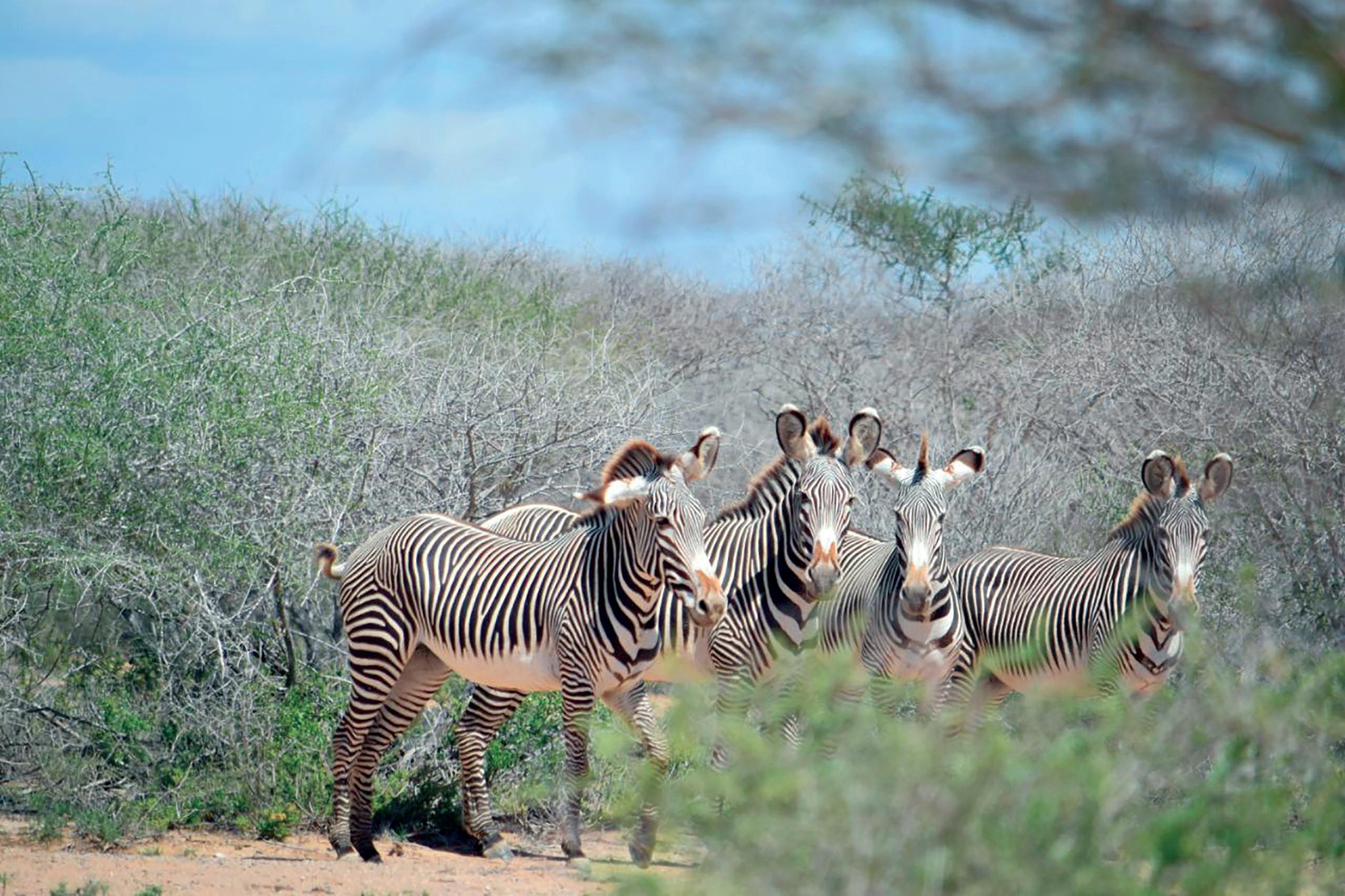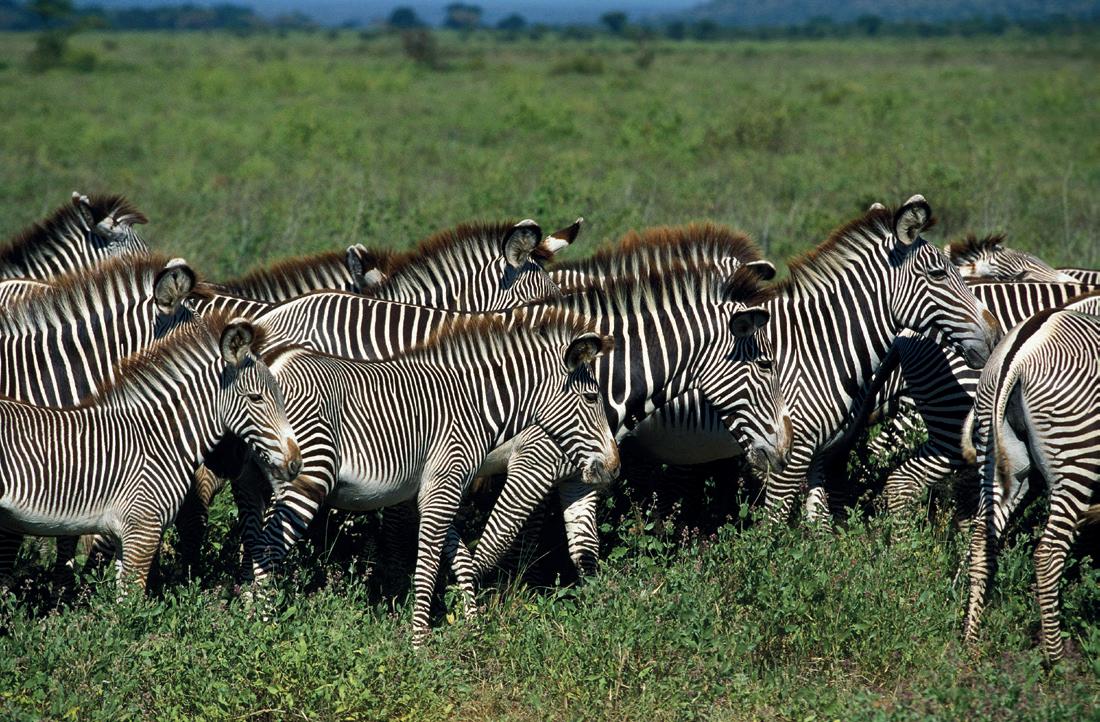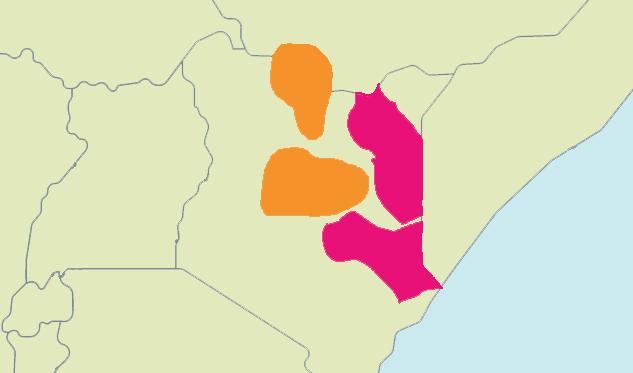
8 minute read
They’re The Zebras the world forgot – and now PTES is helping
zebras The forgot the world
The rarest of the three species of zebra, Grevy’s is quite distinct in having thinner (and more) stripes, a white belly, and fuzzy ears. They are the largest, too, noticeably taller than either plains or mountain zebras.
Advertisement
PTES is supporting a new project to survey and protect a small population of the very rare Grevy’s zebras – a population that, until now, has been ignored by mainstream conservation efforts.

Where did the zebra get its stripes?
There are a number of theories as to why zebras have their bold black-and-white stripes. Three of them – that they protect them against disease-carrying and irritating insects, that they confuse predators, and that they provide the animals with a degree of temperature control under the heat of the African savannah – are discussed below. A fourth idea – that they provide social cohesion for zebras – has not been widely researched and appears to carry little weight.
INSECT DETERRENCE This theory has gained a lot of ground in recent years. A study published in 2019 found that where zebras and plain horses were in the same space, horse flies were far more likely to land on the horses. The same number of flies were seen approaching the zebras as the horses, but they didn’t land on the animal’s skin. Scientists speculate that the stripes somehow deter the flies from being able to land, but it’s not clear what is causing this.
PREDATOR CONFUSION It’s been suggested the stripes on a group of zebras create an optical illusion that confuses predators. For example, when a herd starts to run, do the stripes on the zebras’ bodies make it more difficult for a lion to pick out a single individual? This theory is largely based on a study where human ‘predators’ were challenged to ‘capture’ prey moving across a computer screen and which found that high contrast patterns made this activity harder.
THERMOREGULATION The third theory is that the black part of the coat heats up the animal in the morning, but as the day gets hotter, the white stripes help to cool it down. One report even suggested that the temperature difference between the two causes air movement and increases heat loss through evaporation. Unpublished data suggests zebras in mixed herds have lower surface temperatures than other animals. With its unique black and white stripes making it one of Africa’s – if not the world’s – most distinctive mammals, it can often be forgotten that there is more than one species of zebra. There are in fact three.
Anyone who has travelled to Africa and been on safari is most likely to have seen the plains zebra, the most common species, which is found throughout a broad swathe of the continent from South Africa through to Ethiopia and South Sudan in the north of the continent.
The population of mature adults is estimated to be anywhere between 150,000-250,000 and, though numbers have declined in recent years, the plains zebras are not regarded as being threatened with extinction in any way.
The mountain zebra is found in scattered populations in South Africa, with its real stronghold in Namibia and a very few in Angola. While considerably rarer than the plains, it’s nevertheless reasonably safe from the threat of extinction. Its population is thought to number about 35,000 mature individuals and is stable.
Grevy’s zebras – the largest of the three species – are on a knife edge, however. Mainly found today in central and northern Kenya (with some spillover into southern Ethiopia), they number between 2,000 and 2,500 mature individuals in the wild and are classed as Endangered.
Though fossils found in China, Uzbekistan and South Africa suggest an ancient Grevy’s zebra was once widespread across much of Africa and Asia, in the more recent past they’ve been confined to Central and North Africa. Their range would once have also included Egypt, Sudan, Eritrea, Djibouti and Somalia, but hunting for meat and their coats was probably the key reason why they’ve been eliminated in these countries.
Some conservation work is protecting the zebras in central Kenya, but there’s a smaller and largely ignored population in the east of the country, close to the border with Somalia. Indeed, this population of Grevy’s zebras is so disregarded that the IUCN Red List, the world authority on threatened species, doesn’t even acknowledge they exist.
That’s why we’re funding our longstanding partner, Dr Ali Hussein, to kickstart a project looking at the conservation of Grevy’s zebras in this remote part of northern Kenya. Ali has been working to protect one of the world’s rarest antelopes, the hirola, in this part of the world for many years, and he recently turned his attention to the also rare reticulated giraffe, the species only found in a small corner of the north-eastern countries of Ethiopia, Kenya and Somalia.
And now also to Grevy’s zebras. Ali knows there’s a small population in the counties of Garissa and Wajir, and the first task for him and his team is to try and establish exactly where, and how many, there are. ’The mapping is still ongoing as our team members are in the field identifying where the zebras still occur and also taking photos,’ Ali says. ’So far, we are learning that the population is sparsely distributed, they


What makes a Grevy’s a Grevy?
Debate has raged for many years as to just why zebras have stripes (see box, left). Theories range from stripes helping to confuse predators when zebras move in a herd, to they deter biting flies and other insects. Another possibility is that they help the animals lose heat through evaporation.

SOUTH SUDAN ETHIOPIA
On its own, a Grevy’s might not seem that different from other zebras you are familiar with. But see it side-by-side with a plains zebra (the two species overlap in Kenya), and you can instantly tell just how distinct it is. ► The first thing that strikes you is those stripes – much thinner, and many more of them, than on their close cousins. ► Second, you’ll notice the Grevy’s zebra has a white belly, while the stripes on the plains go all the way round. It has a brown, not black, muzzle. ► Third, the Grevy’s is noticeably taller than the other species and has larger, fuzzy ears. Grevy’s zebra ► Finally, though you can’t see here, it has a black dorsal stripe.
Plains zebra

UGANDA

KENYA
RWANDA
BURUNDI
TANZANIA
are very shy and it will require a lot of effort to trace them.’
Ali tells us that he relies on the networks of herders developed for his hirola work to help identify those areas the zebras use. ‘On a typical day, our scouts traverse these areas in search of the zebras,’ Ali says. ‘When one is sighted, our scouts record details that include its identity, sex and age.’
They take photos using a GPS-enabled digital camera. Each image will be fed into a software programme called Wildbook that identifies each one by their unique coat pattern, and will generate a location for where each one was encountered.
Over time, the photographic record will allow Ali to build up a picture of the abundance of Grevy’s zebras in the region. The resulting database of all individuals will allow the team to track mortality and survival rates in the region. ‘This information will also be used to inform and prioritise a comprehensive, conservation action plan for for Grevy’s zebra within these two counties,’ Ali says.
The habitat in Garissa and Wajir is mainly open grasslands and acacia thorn bush, and rainfall ranges from 200 to 350mm a year. For comparison, in the UK, it’s around 1,500mm a year, so this part of eastern Kenya is very dry, and Ali says rainfall patterns are increasingly unpredictable and fluctuating, leading to an increase in the frequency of drought in the two counties.
This is creating habitat degradation and occasional mass wildlife deaths, an occurrence mainly affecting grassdependent species such as Grevy’s zebras. The scarcity of forage also leads to increased competition with livestock. Zebras, along with giraffes and antelopes, are targeted and killed by illegal bushmeat traders operating along the Kenya-Somalia border.
The long-term plan is to use all the information gathered to establish protected areas in the most important spots for Grevy’s zebras in order to give them a fighting chance of survival.
Involvement of local communities will be key. ‘We will restore the habitat to ensure availability of food for the population and form an anti-poaching unit to monitor and protect the Grevy’s zebras,’ Ali says.
The Grevy’s zebra acquired its name in 1882 when Menelik II, the then King of Abyssinia (now Ethiopia), gave the French president, Jules Grévy, a gift of one. A French zoologist – noticing its distinct appearance (see ‘What makes a Grevy a Grevy’, above) – realised it was different from other known species, and named it after him.
But it’s not just their appearance that makes Grevy’s distinct. Unlike the plains and mountain zebras, Grevy’s don’t form permanent herds and there are no permanent social bonds between adults. Mare-foal ‘units’ are the basis of their social structure, with a number of units combining together to form loose coalitions of no more than 10 mares. These herds are not hierarchical and can change at any time. Similarly, male zebras form loose bachelor groups of up to six stallions.
So next time you see a zebra, perhaps in a nature documentary, in a zoo in this country or even, if you’re lucky enough, in Africa, remember not all of them are the same. And that, as with most conservation issues, protecting these beautiful and highly distinctive equids is far from being a black and white issue. ⚫
SOMALIA
LEFT: The areas marked orange on the map show the official range of the Grevy’s zebra shown by the IUCN Red List. The areas marked pink show the counties of Garissa and Wajir, which Dr Ali Hussein is surveying for their Grevy’s populations.







